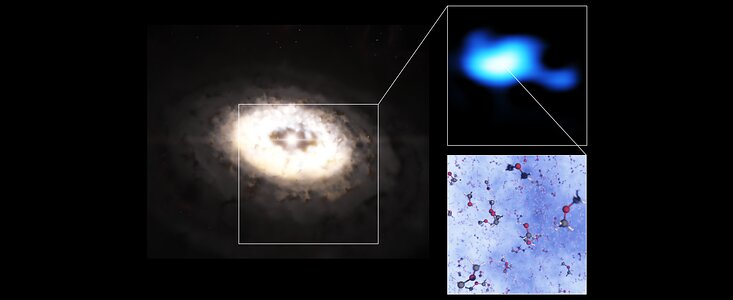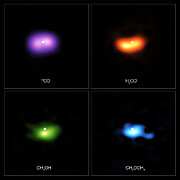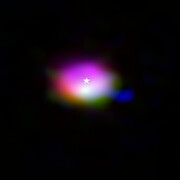Persbericht
Astronomen ontdekken grootste molecuul tot nu toe in een planeet-vormende schijf
8 maart 2022
Met behulp van de Atacama Large Millimeter/submillimeter Array (ALMA) in Chili hebben onderzoekers van de Sterrewacht Leiden voor het eerst dimethylether gedetecteerd in een planeet-vormende schijf. Met negen atomen is dit het grootste molecuul dat tot nu toe in zo’n schijf is aangetroffen. Dimethylether is tevens een voorloper van grotere organische moleculen die kunnen leiden tot het ontstaan van leven.
‘Door deze resultaten kunnen we meer te weten komen over de oorsprong van het leven op onze planeet en daardoor een beter idee krijgen van het potentieel voor leven in andere planetenstelsels. Het is erg spannend om te zien hoe deze bevindingen in het grotere plaatje passen,’ zegt Nashanty Brunken, masterstudent aan de Sterrewacht Leiden (onderdeel van de Universiteit Leiden) en hoofdauteur van het onderzoek waarvan de resultaten vandaag in Astronomy & Astrophysics zijn gepubliceerd.
Dimethylether is een organisch molecuul dat vaak voorkomt in stervormingsgebieden, maar dat nog nooit eerder is aangetroffen in een planeet-vormende schijf. De onderzoekers hebben ook aanwijzingen gevonden voor de aanwezigheid van methylformiaat, een complex molecuul dat op dimethylether lijkt en tevens een bouwsteen is voor nog grotere organische moleculen.
‘Het is echt opwindend om eindelijk deze grotere moleculen in schijven te detecteren. Een tijd lang dachten we dat het misschien niet mogelijk was om ze waar te nemen,’ zegt co-auteur Alice Booth, eveneens onderzoeker aan de Sterrewacht Leiden.
De moleculen werden ontdekt in de planeet-vormende schijf rond de jonge ster IRS 48 (ook bekend als Oph-IRS 48) met behulp van ALMA, een sterrenwacht die mede-eigendom is van de Europese Zuidelijke Sterrenwacht (ESO). IRS 48, die zich op een afstand van 444 lichtjaar in het sterrenbeeld Ophiuchus (Slangendrager) bevindt, is het onderwerp geweest van talrijke studies, omdat zijn schijf een asymmetrische, cashewnoot-vormige ‘stofval’ bevat. Dit gebied, dat waarschijnlijk is gevormd door een pasgeboren planeet of een kleine stellaire begeleider die zich tussen de moederster en de stofval bevindt, bevat grote aantallen stofkorrels van millimeterformaat die kunnen samenklonteren tot objecten van kilometerformaat, zoals kometen, planetoïden en mogelijk zelfs planeten.
Vermoed wordt dat veel complexe organische moleculen, zoals dimethylether, ontstaan in stervormingsgebieden, nog voordat daarin sterren zijn geboren. In deze koude omgevingen hechten atomen en eenvoudige moleculen zoals koolstofmonoxide zich aan stofkorrels, waarop ze een ijslaagje vormen en chemische reacties ondergaan, die in de vorming van complexere moleculen resulteren. Onderzoekers hebben onlangs ontdekt dat de stofval in de schijf van IRS 48 tevens een ijsreservoir is, waar zich stofkorrels bevinden die bedekt zijn met ijs dat rijk is aan complexe moleculen. Het is in dit gebied van de schijf dat ALMA nu tekenen van het dimethylether-molecuul heeft waargenomen: onder invloed van de warmte van IRS 48 sublimeert het ijs tot gas, en komen de ingevangen moleculen die van koude wolken zijn ‘geërfd’ vrij en worden ze detecteerbaar.
‘Wat dit nog opwindender maakt, is dat we nu weten dat deze grotere complexe moleculen beschikbaar zijn als voeding voor planeten-in-wording in de schijf,’ legt Booth uit. ‘Dit was tot nu toe niet bekend, omdat deze moleculen doorgaans verscholen zitten in het ijs.’
De ontdekking van dimethylether suggereert dat ook veel andere complexe moleculen die gewoonlijk in stervormingsgebieden te vinden zijn zich in de ijzige structuren in planeet-vormende schijven kunnen verschuilen. Deze moleculen zijn de voorlopers van prebiotische moleculen zoals aminozuren en suikers, die tot de basisbouwstenen van het leven behoren.
Door hun vorming en evolutie te bestuderen, kunnen onderzoekers dus beter begrijpen hoe prebiotische moleculen op planeten zoals de onze terechtkomen. ‘We zijn ongelooflijk blij dat we nu de hele reis van deze complexe moleculen kunnen gaan volgen, van de wolken waarin zich sterren vormen, tot planeet-vormende schijven en kometen aan toe. Hopelijk kunnen we met meer waarnemingen een stap dichter bij het begrijpen van de oorsprong van prebiotische moleculen in ons eigen zonnestelsel komen,’ zegt Nienke van der Marel, onderzoeker aan de Sterrewacht Leiden die eveneens aan het onderzoek heeft meegewerkt.
Toekomstige onderzoeken van IRS 48 met ESO’s Extremely Large Telescope (ELT), die momenteel in Chili wordt gebouwd en later dit decennium in gebruik zal worden genomen, zullen het team in staat stellen de chemie van de binnenste regionen van de schijf te bestuderen, waar zich aarde-achtige planeten zouden kunnen vormen.
Meer informatie
De resultaten van dit onderzoek zijn te vinden in het artikel ‘A major asymmetric ice trap in a planet-forming disk: III. First detection of dimethyl ether’ (doi: 10.1051/0004-6361/202142981) dat in Astronomy and Astrophysics verschijnt.
Deze publicatie is uitgebracht op Internationale Vrouwendag 2022 en bevat onderzoek dat is verricht door zes onderzoekers die zich als vrouw identificeren.
Het onderzoeksteam bestaat uit Nashanty G.C. Brunken (Sterrewacht Leiden, Universiteit Leiden [Leiden]), Alice S. Booth (Leiden), Margot Leemker (Leiden), Pooneh Nazari (Leiden), Nienke van der Marel (Leiden), Ewine F. van Dishoeck (Sterrewacht Leiden, Max-Planck-Institut für extraterrestrische Physik, Garching, Duitsland).
De Europese Zuidelijke Sterrenwacht (ESO) stelt wetenschappers van over de hele wereld in staat om de geheimen van het heelal te ontdekken, ten bate van iedereen. Wij ontwerpen, bouwen en exploiteren observatoria van wereldklasse die door astronomen worden gebruikt om spannende vragen te beantwoorden en de fascinatie voor astronomie te verspreiden, en bevorderen internationale samenwerking op het gebied van de astronomie. ESO, in 1962 opgericht als intergouvernementele organisatie, wordt inmiddels gedragen door 16 lidstaten (België, Denemarken, Duitsland, Finland, Frankrijk, Ierland, Italië, Nederland, Oostenrijk, Polen, Portugal, Spanje, Tsjechië, het Verenigd Koninkrijk, Zweden en Zwitserland) en door het gastland Chili, met Australië als strategische partner. Het hoofdkwartier van de ESO en haar bezoekerscentrum en planetarium, de ESO Supernova, zijn gevestigd nabij München in Duitsland, maar onze telescopen staan opgesteld in de Chileense Atacama-woestijn – een prachtige plek met unieke omstandigheden voor het doen van hemelwaarnemingen. ESO exploiteert drie waarnemingslocaties: La Silla, Paranal en Chajnantor. Op Paranal staan ESO’s Very Large Telescope en Very Large Telescope Interferometer, evenals twee surveytelescopen: VISTA voor infrarood en de VST voor zichtbaar licht. Op Paranal zal de ESO ook de Cherenkov Telescope Array South huisvesten en exploiteren – ’s werelds grootste en gevoeligste observatorium van gammastraling. Samen met internationale partners beheert ESO APEX en ALMA op Chajnantor, twee faciliteiten die de hemel waarnemen in het millimeter- en submillimetergebied. Op Cerro Armazones, nabij Paranal, bouwen wij ‘het grootste oog ter wereld’ – ESO’s Extremely Large Telescope. Vanuit onze kantoren in Santiago, Chili, ondersteunen wij onze activiteiten in het gastland en werken wij samen met Chileense partners en de Chileense samenleving.
Links
• Kom meer te weten over ESO’s Extremely Large Telescope
• Voor journalisten: abonneer je op persberichten in je eigen taal
• Voor wetenschappers: heb je een verhaal? Promoot je onderzoek
Contact
Nashanty Brunken
Leiden Observatory, Leiden University
Leiden, The Netherlands
E-mail: brunken@strw.leidenuniv.nl
Alice Booth
Leiden Observatory, Leiden University
Leiden, The Netherlands
Tel: +31 71 527 5737
E-mail: abooth@strw.leidenuniv.nl
Nienke van der Marel
Leiden Observatory, Leiden University
Leiden, The Netherlands
Tel: +31 71 527 5872
E-mail: nmarel@strw.leidenuniv.nl
Bárbara Ferreira
ESO Media Manager
Garching bei München, Germany
Tel: +49 89 3200 6670
Mob: +49 151 241 664 00
E-mail: press@eso.org
Rodrigo Alvarez (press contact België)
ESO Science Outreach Network
en Planetarium, Royal Observatory of Belgium
Tel: +32-2-474 70 50
E-mail: eson-belgië@eso.org
Over dit bericht
| Persberichten nr.: | eso2205nl-be |
| Naam: | IRS 48, Oph-IRS 48 |
| Type: | Milky Way : Star : Circumstellar Material : Disk : Protoplanetary |
| Facility: | Atacama Large Millimeter/submillimeter Array |
| Science data: | 2022A&A...659A..29B |
Our use of Cookies
We use cookies that are essential for accessing our websites and using our services. We also use cookies to analyse, measure and improve our websites’ performance, to enable content sharing via social media and to display media content hosted on third-party platforms.
ESO Cookies Policy
The European Organisation for Astronomical Research in the Southern Hemisphere (ESO) is the pre-eminent intergovernmental science and technology organisation in astronomy. It carries out an ambitious programme focused on the design, construction and operation of powerful ground-based observing facilities for astronomy.
This Cookies Policy is intended to provide clarity by outlining the cookies used on the ESO public websites, their functions, the options you have for controlling them, and the ways you can contact us for additional details.
What are cookies?
Cookies are small pieces of data stored on your device by websites you visit. They serve various purposes, such as remembering login credentials and preferences and enhance your browsing experience.
Categories of cookies we use
Essential cookies (always active): These cookies are strictly necessary for the proper functioning of our website. Without these cookies, the website cannot operate correctly, and certain services, such as logging in or accessing secure areas, may not be available; because they are essential for the website’s operation, they cannot be disabled.
Functional Cookies: These cookies enhance your browsing experience by enabling additional features and personalization, such as remembering your preferences and settings. While not strictly necessary for the website to function, they improve usability and convenience; these cookies are only placed if you provide your consent.
Analytics cookies: These cookies collect information about how visitors interact with our website, such as which pages are visited most often and how users navigate the site. This data helps us improve website performance, optimize content, and enhance the user experience; these cookies are only placed if you provide your consent. We use the following analytics cookies.
Matomo Cookies:
This website uses Matomo (formerly Piwik), an open source software which enables the statistical analysis of website visits. Matomo uses cookies (text files) which are saved on your computer and which allow us to analyze how you use our website. The website user information generated by the cookies will only be saved on the servers of our IT Department. We use this information to analyze www.eso.org visits and to prepare reports on website activities. These data will not be disclosed to third parties.
On behalf of ESO, Matomo will use this information for the purpose of evaluating your use of the website, compiling reports on website activity and providing other services relating to website activity and internet usage.
Matomo cookies settings:
Additional Third-party cookies on ESO websites: some of our pages display content from external providers, e.g. YouTube.
Such third-party services are outside of ESO control and may, at any time, change their terms of service, use of cookies, etc.
YouTube: Some videos on the ESO website are embedded from ESO’s official YouTube channel. We have enabled YouTube’s privacy-enhanced mode, meaning that no cookies are set unless the user actively clicks on the video to play it. Additionally, in this mode, YouTube does not store any personally identifiable cookie data for embedded video playbacks. For more details, please refer to YouTube’s embedding videos information page.
Cookies can also be classified based on the following elements.
Regarding the domain, there are:
- First-party cookies, set by the website you are currently visiting. They are stored by the same domain that you are browsing and are used to enhance your experience on that site;
- Third-party cookies, set by a domain other than the one you are currently visiting.
As for their duration, cookies can be:
- Browser-session cookies, which are deleted when the user closes the browser;
- Stored cookies, which stay on the user's device for a predetermined period of time.
How to manage cookies
Cookie settings: You can modify your cookie choices for the ESO webpages at any time by clicking on the link Cookie settings at the bottom of any page.
In your browser: If you wish to delete cookies or instruct your browser to delete or block cookies by default, please visit the help pages of your browser:
Please be aware that if you delete or decline cookies, certain functionalities of our website may be not be available and your browsing experience may be affected.
You can set most browsers to prevent any cookies being placed on your device, but you may then have to manually adjust some preferences every time you visit a site/page. And some services and functionalities may not work properly at all (e.g. profile logging-in, shop check out).
Updates to the ESO Cookies Policy
The ESO Cookies Policy may be subject to future updates, which will be made available on this page.
Additional information
For any queries related to cookies, please contact: pdprATesoDOTorg.
As ESO public webpages are managed by our Department of Communication, your questions will be dealt with the support of the said Department.










